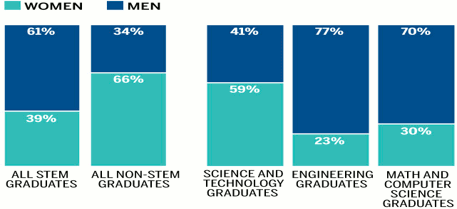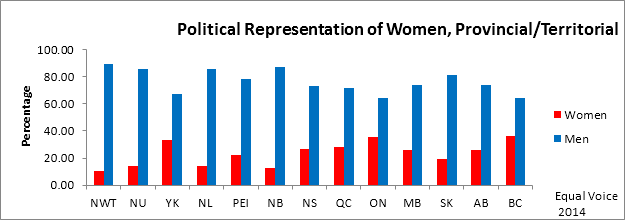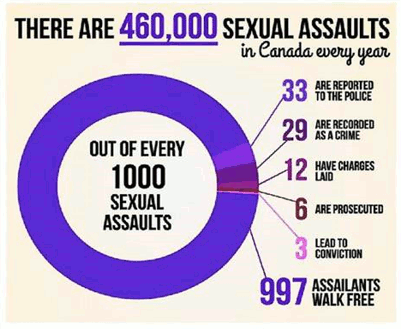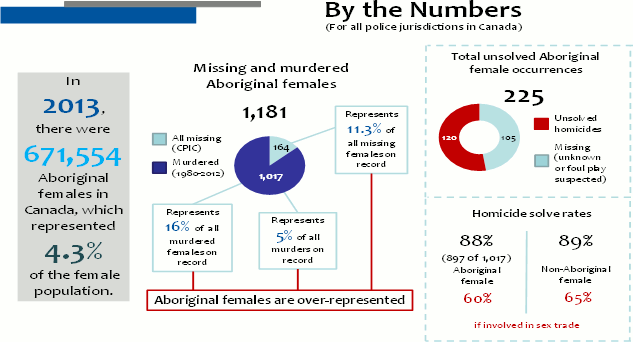Archived information
This content is archived because Status of Women Canada no longer exists. Please visit the Women and Gender Equality Canada.
Archived information is provided for reference, research or recordkeeping purposes. It is not subject to the Government of Canada Web Standards and has not been altered or updated since it was archived. Please contact us to request a format other than those available.
Status of Women Canada Ministerial Transition Book
Women in Canada: Key Trends
Overview
Women and girls in Canada are doing comparatively well when measured against other western countries (see recent Women and Girls in Canada presentation outlining key themes). International reports continue to rank Canada highly for its achievement of gender equality. Most recently, the World Economic Forum’s 2014 Global Gender Gap Report ranked Canada 19th out of 142 countries, an improvement from 20th in 2013 and 21st in 2012.
In 2013, the UN Development Program’s Human Development Report (HDR), which assesses long-term progress in human development, ranked Canada 8th out of 187 countries. The HDR also includes the Gender Inequality Index (GII), which assesses the gender gap in indicators for health, education, labour force participation and parliamentary representation. In 2014, the GII ranked Canada 23rd out of 187 countries (down from 18th place in 2013). In 2012, TrustLaw, which ranks G20 countries on where it is best to be a woman, ranked Canada number 1. These rankings are primarily due to the gains women have made in education, labour force participation, health and parliamentary representation.
Despite these gains, Canadian women continue to face challenges in achieving full equality in Canada. Women earn less than their male counterparts, are less represented in positions of power, and are far more likely than men to be affected by most forms of violence. In addition, certain groups of women are more likely to be affected by these challenges, including Aboriginal women and girls, immigrant women, and rural women.
This document provides a brief snapshot of some of the key issues facing women in Canada, including:
- education and skills training;
- employment and economic wellbeing;
- unpaid work;
- leadership and democratic participation; and
- violence against women and girls.
Each section begins with an overview of positive trends within the domain, followed by sub-sections on key challenges going forward.
Note that more comprehensive statistical information on these and other issues such as women and health, women and the criminal justice system, women with disabilities, Aboriginal women, immigrant women and visible minority women can be found in the Women in Canada: A Gender-based Statistical Report from Statistics Canada. This document is currently being updated, with chapters being released over the course of 2015–2016.
Education and Skills Training
Education indicators for Canadian women are strong, with girls’ achievements outperforming those of boys as early as elementary school. As girls progress in education, they are more likely to graduate from high school in a shorter period of time and less likely to drop out. More women than men enroll in post secondary programs after completing high school, and more women complete these programs. This said, segmentation of women into certain educational disciplines leaves women unable to take advantage of employment opportunities in key growth sectors.
Positive Trends
- Women became the majority of university graduates in Canada in the early 1990s and now represent roughly 58% of post-secondary graduates
- Approximately 75% of working age women hold a post-secondary credential
- Internationally, Canadian women have the highest tertiary education attainment rate (55%) among women or men from OECD countries
- Women’s representation in some educational disciplines, including the sciences, has increased significantly over the last 30 years, including engineering and medicine
Ongoing Challenges
Gender segmentation in education and training is a key challenge in terms of women’s educational achievement. Indicators of this include:
- Women represent 39% of graduates from Science, Technology, Engineering and Mathematics (STEM) programs in Canada
- In 2011, women accounted for only 14% of registered apprentices and were concentrated in certain trades, including as hairstylists (80%) and cooks (about 30%), with small proportions in most other trades
- Women account for only 2% of carpentry apprentices, 1.9% of plumbing apprentices, and 1.5% of heavy equipment apprentices

Source : Statistics Canada | Graphic: Amanda Shendruk
Figure 1: Women and Men in STEM Education
[Text version of Figure 1: Women and Men in STEM Education]
Image is a bar graph in green and blue. Green represents women; blue represents men.
The first bar shows all STEM graduates — 39% women; 61% men.
The second bar shows all non-STEM graduates — 66% women; 34% men.
The third bar shows all science and technology graduates — 59% women; 41% men.
The fourth bar shows engineering graduates — 23% women; 77% men.
The fifth bar shows math and computer science graduates — 30% women; 70% men.
Employment and Economic Wellbeing
Since the early 1980s, women have made increasing strides in terms of labour market participation and economic independence. At roughly 68%, Canada’s labour force participation rate for women aged 15 to 74 is fourth in the OECD and was 9% higher than the OECD average of 59%. Despite women’s increased economic participation, there are a number of challenges that continue to limit their economic potential, such as their overrepresentation in part-time work and disruptions in labour market attachment due to care responsibilities, both of which contribute to the gender wage gap.
Positive Trends
- Women’s labour market participation has consistently increased over the last 30 years (Figure 2)
- In 2014, women represented 47.3% of the labour force, up from 45.7% in 1999 and 37.1% in 1976
- The employment rate of women with children has been increasing, with 72.9% of women with children under 16 working in the paid labour force
Labour force participation rate (15-64), by gender, 1976-2012

Figure 2: Labour Force Participation of Women 1976–2012
Text version of Figure 2: Labour force participation rate (15-64), by gender, 1976-2012
The image is a line graph showing the rates of participation in the labour force by men and women aged 15 to 64.
Women are represented by a red line which begins with 51.4% in 1976 and rises to 74.3% in 2012.
Men are represented by a blue line which begins with 84.5% in 1976 and declines slightly to 81.6% in 2012.
Ongoing Challenges
Despite progress, the Gender Wage Gap remains a challenge for many Canadian women
- Depending on the variables measured, estimates for Canada’s wage gap vary:
- Average earnings for women in all job tenures (as percentage of men’s earnings) were 67% in 2011, suggesting a gap of over 30%
- When measuring full-time job tenure only, women earn roughly 20% less than men working full-time in Canada,women representing over 70% of part-time workers, measurement of the wage gap by full time employment status only conceals the full extent of the gap
- The wide range of factors that influence the wage gap (and the connections between them) has made addressing this issue an ongoing challenge across all levels of government
Many factors influence women’s lower earnings in comparison to their male counterparts. These include:
- Disruptions in women’s careers due to having children and/or providing care for children or loved ones can affect their career trajectory, including by influencing their lower representation in management
- In 2014, women accounted for 36% of managers in Canada
- Labour market segmentation has an impact on women’s incomes. Women’s employment is concentrated in lower paying sectors, including retail and health and social services (Figure 3)
- In 2013 in the services-producing sectors women accounted for 55% of employment, while men accounted for 45% of employment
- In the goods-producing sectors, where wages are higher, men accounted for 78.8% of employment, while women accounted for 21.2% of employment
- The low representation of women in STEM fields is also notable. In 1987, just 20% of those working in STEM fields were women. This number has increased by just 2 percentage points in 2015, with 22% of workers in STEM fields being women
- Many women are not successful in finding employment in STEM fields. The number of STEM graduates in 2011 was 39%
- Women continue to have low representation in the skilled trades
- For example, in 2012, women held just 11.8% of construction jobs, 19% of forestry, fishing, mining, oil, and gas jobs, and 30.5% of agricultural jobs
Overall, women represent roughly 5% of all skilled trades workers in Canada
Marginalized women and the economy
- Certain groups of women in Canada are more vulnerable to economic inequalities
- Overall, 13.3% of women live in poverty, however Aboriginal women and single mothers experience even higher rates, at 30% and 36% respectively
- At close to 45% of families under the low-income cut-off (LICO), female headed lone parent families are more likely to live in poverty than two parent families
- Among university educated women working full time, employment income averaged $64,500 among those with disabilities, compared to $68,000 among those without disabilities
- Over 68% of immigrant women aged 25 to 54 are employed, about 11 points lower than the rate for their Canadian-born counterparts
- Over 53% of Aboriginal women are employed, in comparison to more than 58% of women in Canada overall
Unpaid Work
Unpaid work refers to responsibilities that fall outside of formal employment, including child care, care for sick or elderly family members, and domestic work, including cleaning. Although women have traditionally done much of the unpaid work in a household, men are taking on an increased role. This said, women still provide the majority of high intensity care (15 hours or more). Their overrepresentation in unpaid work leaves women at a disadvantage in Canada’s increasingly competitive labour market.
Positive Trends
- Since the introduction of federal benefits for parental leave, roughly 20% of eligible partners/fathers are using this form of leave, up from 3% in 2000
- In Quebec, the introduction of the 5 week parental leave for fathers in 2006 resulted in a jump from 23% of fathers taking leave, to 53%
- Men are also taking on more household responsibilities (unpaid household work including housework, child care or shopping for goods and services) with each successive generation
- Generation Y women (defined by Statistics Canada as women born between 1981 and 1990) did 53% of the total housework in a domestic partnership, down from 59% for their female counterparts in Generation X (defined as women born between 1969–1978)
Ongoing Challenges
Despite these positive developments, women are still doing the bulk of unpaid work, which is a primary influence on their labour market attachment
- Women spend more time than men caring for their children. In 2010, women spent an average of 50.1 hours per week on unpaid child care, more than double that spent by men (24.4 hours)
- Women spend more time than men on domestic work. In 2010, while women spent 13.8 hours per week doing housework, men spent 8.3 hours
Other forms of care
- Women are also more likely to find themselves providing high intensity care - representing nearly 70% of those 45 years of age and older providing 15 or more hours of care per week
- In 2010, women were almost twice as likely as men (49% compared to 25%) to spend more than 10 hours per week caring for a senior
Leadership and Democratic Participation
Canadian women continue to gain ground in terms of representation at the highest levels of economic and political life. However, change is coming slowly. While new provincial and territorial guidelines regarding transparency on board gender balance have been introduced across jurisdictions, the long term impacts of this are yet to be seen. At the political level, women’s representation falls under the 30% threshold defined by the UN as the minimum level necessary for women to exercise real influence. Research suggests that women are more engaged at the grassroots level of democracy as opposed to seeking elected positions.
Positive Trends
- Women are consistently gaining ground in terms of elected representation in successive federal elections, to an all time high of 25% in the 42nd Parliament (November 2015)
- The 42nd federal Parliament included the highest number of female cabinet ministers ever, at 22%
- In terms of business leadership, representation of women in board roles is at an all-time high at roughly 21% in the private sector
- Research also suggests that having a more diverse corporate board of directors may lead to stronger financial performance for companies
- FP500 companies with higher representation of women on their boards demonstrated a 26% higher return on investment
- Within federal Governor-in-Council (GIC) appointments, women represent 33% of all senior appointments, including those to crown corporations and federal boards
- Representation of women at the highest levels of the federal public service is also very strong, with women representing roughly 42% of all senior executive positions
Ongoing Challenges
Women under-represented on private sector boards
- Women represent just 16% of FP500 board members, and 40% of FP500 companies have no women on their boards
- Some sectors of the economy have higher representation of women on boards, such as the banking sector where roughly 22% of board directors are women
- Other sectors, including mining and manufacturing, have much lower representation, at 7% and 9.4% respectively
Women under-represented in decision-making positions over-all
- Women represent over 47% of the Canadian Labour Force, but are under-represented in key decision-making positions (Figure 3)

Sources
Catalyst, Women CEOs and Heads of the Financial Post 500 (2 janiver 2015) and additional Catalyst research and analysis
Liz Mulligan-Ferry, Mark J. Bartkiewicz, Rachel Soares, Amrita Singh, et Imogene Winkleman, 2013 Catalyst Census: Financial Post 500 Women Board Directors (2014)
Liz Mulligan-Ferry, Andrew Malordy, et Ashley Peter, 2012 Catalyst Census: Financial Post 500 Women Senior Officers and Top Earners (2013)
Statistics Canada, Table 282-0010 Labour Force Survey Estimates (LFS), by National Occupational Classification for Statistics (NOC-S) and Sex Annual Characteristics: Employment (January 2014)
Figure 3: Canadian Women in Business Leadership
[Text version of Figure 3: Canadian Women in Business Leadership]
The image is a triangle divided horizontally into seven sections. The first six sections of the triangle are in different shades of blue with white text. The bottom section is in red with white text.
The top of the triangle is the smallest section and represents the 4.9% of CEOs/Heads who are women.
The section just underneath represents the 6.9% of top earners who are women.
The third section represents women board directors at 15.9%.
The fourth section is women senior officers, at 18.1%.
The fifth section represents the percentage of women in management occupations, with 35.7%.
The sixth section represents the percentage of women in the Canadian Labour Force, with 47.3%.
At the bottom of the triangle, the chart is labeled “Canadian Women in Business”.
Women under-represented in politics
- Representation of women at all levels of government in Canada, including representation at the provincial and territorial level (Figure 4) is low compared to men

Figure 4: Women's Political Representation in Canadian Provinces and Territories
[Text version of Figure 4: Women's Political Representation in Canadian Provinces and Territories]
The image is a bar graph. The title is “Political Representation of Women, Provincial/Territiorial”
On the y axis are percentages ranging from 0.00 to 100.00. On the x axis, the provinces and territories are listed in the following order (from left to right): Northwest Territories (NWT), Nunavut (NU), Yukon (YK), Newfoundland and Labrador (NL), Prince Edward Island (PEI), New Brunswick (NB), Nova Scotia (NS), Quebec (QC), Ontario (ON), Manitoba (MB), Saskatchewan (SK), Alberta (AB) and British Columbia (BC). Women are represented by a red bar, men by a blue.
The data displayed is as follows (percentages are approximate):
- NWT: women 10%; men 90%.
- NU: women 15%; men 85%.
- YK: women 30%; men 70%.
- NL: women 15%; men 85%.
- PEI: women 20%; men 80%.
- NB: women 10%; men 90%.
- NS: women 25%; men 75%.
- QC: women 27%; men 73%.
- ON: women 35%; men 65%.
- MB: women 25%; men 75%.
- SK: women 18%; men 82%.
- AB: women 25%; men 75%.
- BC: women 35%; men 65%.
The graph is credited to Equal Voice, 2014.
Violence Against Women and Girls
The issue of violence against women and girls continues to be a complex challenge. Rates of sexual assault and intimate partner violence have remained persistently high in Canada, with 1.8 million Canadians, the majority of whom are women, reporting having experienced one of these forms of violence in the past five years. The issue of violence is particularly acute with respect to Aboriginal women and girls in Canada.
Positive Trends
- There has been almost a 50% decrease in intimate partner homicide against women between 1993–2013, with an overall declining trend since the mid-1970s
- In addition, services to support victims of intimate partner violence have significantly increased across the country
- In 2013, 627 shelters were in operation across Canada, an increase of more than 17% since 2000
Ongoing Challenges
Women are particularly vulnerable to certain forms of violence. Women:
- Account for nearly 80% of all police-reported intimate partner violence
- Are 11 times more likely than men to be victims of sexual offences
- Are 3 times more likely than men to experience criminal harassment (eg. stalking)
Underreporting is a serious challenge
- Underreporting is a significant issue that challenges the capacity of police, health care providers and lawmakers, among others, to understand the true severity of sexual violence in Canada (Figure 5)
- It is estimated that for every 1000 sexual assaults in Canada, only 33 are reported to police

Source : Johnson, "Limits of a Criminal Justice Response: Trends in Police and court Processing of Sexual Asssault" in Sheehy, Sexual Assault in Canada: Law, Legal Practice and Women's Activism, 2012.
Figure 5 Underreporting of Sexual Violence in Canada
[Text version of Figure 5: Underreporting of Sexual Violence in Canada]
The title of the image is “There are 460,000 sexual assaults in Canada every year”. The image shows a circle containing the words “out of every 1,000 sexual assaults”. Sections of this circle are labeled as follows:
- 33 are reported to the police
- 29 are recorded as a crime
- 12 have charges laid
- 6 are prosecuted
- 3 lead to conviction
- 997 assailants walk free
Certain groups of women are more likely to face victimization
- Immigrant women tend to under-report due to isolation, fear of deportation, and experiences of language and cultural barriers
- Women with disabilities experience physical and sexual violence at 3 to 4 times the rate of women without disabilities
- Lesbian and bisexual women are three times more likely than heterosexual women to report spousal violence
- Women living in the territories consistently report significantly higher levels of violence; remote and isolated communities face particular challenges related to access and availability of supports
Aboriginal women across the country experience significantly more violence than non-aboriginal women
- Aboriginal women living in the provinces and territories are nearly 3 times more likely to experience violence than non-Aboriginal women
- Aboriginal women are overrepresented among Canada’s missing and murdered
- Based on the RCMP’s 2014 Operational Overview, we know that despite making up 4% of the population, Aboriginal women account for 16% of all murdered females between 1980 and 2012 (Figure 6)
- A 2015 update to the Operational Overview, focused on RCMP jurisdictions, reported that there were 32 homicides of Aboriginal women in 2013 and 2014, which is consistent with trends over the past decade

Figure 6 Missing and Murdered Aboriginal Women
[Text version of Figure 6: Missing and Murdered Aboriginal Women]
The image title is “By the Numbers”. It shows data for all police jurisdictions in Canada.
On the left is a shaded box containing the following text: “In 2013, there were 671, 554 Aboriginal females in Canada, which represented 4.3% of the female population.”
In the centre, is a pie chart entitled “Missing and murdered Aboriginal females. The total number represented by the pie chart is 1,181. The smallest section of the pie chart is light blue and represents the 164 missing Aboriginal women, based on data from CPIC. It is labeled as follows: “11.3% of all missing females on record”.
The larger section of the pie chart is dark blue and represents all 1,017 Aboriginal women and girls murdered between 1980 and 2012. This section is labeled as follows: “Represents 5% of all murders on record” and “represents 16% of all murdered females”.
Both sections of the pie chart are labeled: “Aboriginal females are over-represented”.
On the right side of the image is a box entitled: “Total unsolved Aboriginal female occurrences”. Beneath the title, the number 225 appears. Underneath this is a circle divided into two sections. The section on the left represents unsolved homicides and contains the number 120. The section on the right contains the number 105 and represents missing women (unknown or foul play suspected).
Underneath this, homicide solve rates are displayed. On the left, it shows that 88% (897 of 1,017) of the murders of Aboriginal females have been solved; for female Aboriginal victims involved in the sex trade, the solve rate was 60%. On the right is the homicide solve rate for non-Aboriginal females, at 89%; 65% for non-Aboriginal female victims involved in the sex trade.
Higher rates of violence against Aboriginal women are associated with socio-economic factors. Aboriginal women at risk of violence are more likely to:
- Be young, and single
- Have higher levels of unemployment
- Have lower levels of education
- Have been impacted directly or indirectly by residential school experiences
- Date modified: